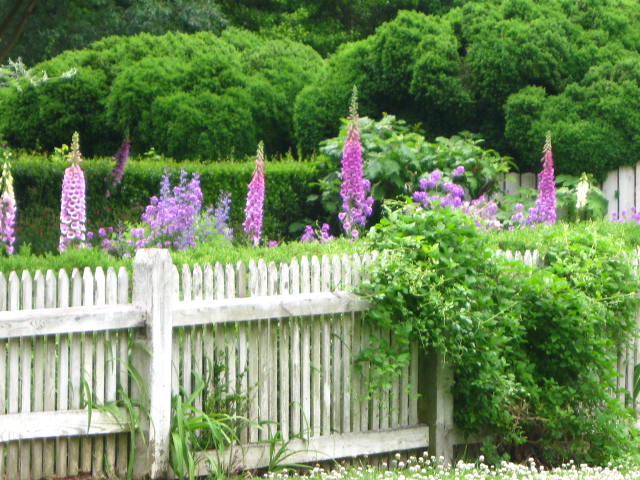Some colonials homes:
and their more modest gardens. I loved all the foxgloves!
Or quench your thirst at the Raleigh Tavern, where Washington often dined, as well as many leading Virginians. There were more serious occasions for resorting to the Raleigh as well. When the House of Burgesses protested the Townshend Acts in 1769 and Governor Botetourt dissolved the chamber for its disrespect, bolder members reconvened at the tavern. There they formed a non-importation association, agreeing to suspend the purchase of various goods from British merchants. It would have been called a boycott, but the word would not be invented for another 111 years.
Established about 1717, the Raleigh's namesake was Sir Walter Raleigh, who had attempted the first colonization of Virginia in 1585. His lead bust stood above the door and, during public times in April and October, planters and merchants from all over the colony passed beneath it on the way to the court. Some adjourned to play dice in the gaming room or to feast in the dining room.
Spinning was a domestic chore not practiced much in colonial Virginia,as it was very time consuming. Most cloth was imported. When trade with England was restricted during the Revolution, newly-established cloth factories supplied the state's textile needs. Local newspaper advertisements indicate that hemp and linen cloth were being produced in Virginia by 1777.
|
All the wood shavings made me miss my dad and his workshop!
Cloth for making campaign tents and sails, both essential during wartime!
I wonder what is causing this patriot to have such a look of dismay? Something tells me that Benedict Arnold may be putting in an appearance tomorrow! Stay tuned for all the action...and some heated words!
Here is a poem that might have been familiar to the man above, once again taken from Jefferson's Scrapbook of Poems. It's titled Song, and I can just see this guy shouting "a plague on you" as Arnold rode into Williamsburg!
A Plague on those snivelling coxcombs, say I,
Who would sell for a sixpence, their freedom;
About poverty, ruin and hardship they cry,
And think that the People will heed 'em.
When hungry I've fought, and and when naked I've toil'd
For Freedom, the greatest of treaures;
No hardship could move me when Liberty smil'd,
I laugh'd at effeminate pleasures.


















No comments:
Post a Comment